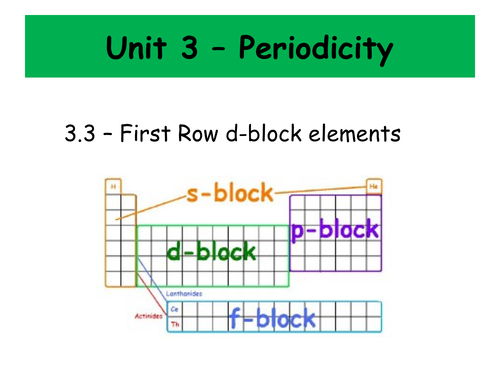








These two PowerPoints were planned as part of the IB scheme of work on Periodicity, including Transition Metal Chemistry and the Chemistry behind coloured complexes, and cover the necessary content for both the Higher Level topics. It would also be suitable for other post-16 courses.
Included are fully completed PowerPoints, student versions of the PowerPoints with sections to complete independently and some exam style questions.
Topics included are:
- Electronic structures of the Transition Metals
- Electronic structures of Transition Metal ions
- The definition of a Transition Metal
- Properties of Transition Metals
- Variable oxidation states and the trend in First Ionisation Energies
- Paramagnetism and Diamagnetism
- Complex Ions
- Transition Metals as catalysts
- How colour occurs in compounds
- Ligand Field Theory
- Which Transition Metals are coloured and which are colourless and why
- Factors which affect colour - including identity of the metal, charge on the metal and identity of the ligand
Get this resource as part of a bundle and save up to 25%
A bundle is a package of resources grouped together to teach a particular topic, or a series of lessons, in one place.
Atomic Structure, Periodicity and Structure and Bonding
These PowerPoints were planned as part of the IB schemes of work on Atomic Structure, Periodicity (including transition metal chemistry and coloured complexes) and Structure and Bonding. They cover the necessary content for both the Standard and Higher Level topics. They would also be suitable for other post-16 courses. Included are fully completed PowerPoints, student versions of the PowerPoints with sections to complete independently and some exam style questions.
Atomic Structure and Periodicity
These PowerPoints were planned as part of the IB schemes of work on Atomic Structure and Periodicity (including transition metal chemistry and coloured complexes) and cover the necessary content for both the Standard and Higher Level topics. They would also be suitable for other post-16 courses. Included are fully completed PowerPoints, student versions of the PowerPoints with sections to complete independently and some exam style questions. Topics included are: \- The structure of the atom \- The development of the theory of atomic structure from Dalton-present day \- Isotopes and their properties \- Calculating the R.A.M. of an isotope \- Calculating the % abundance of two isotopes, given the R.A.M. \- Radioisotopes and their uses \- The mass spectrometer: what it is used for, how it works, why it works and how to read mass spectra \- How to calculate the energy of a photon of light \- Atomic Emission Spectra \- How to write full electronic configurations for elements up to the 4p orbital \- How to write full electronic configurations for ions of the elements up to the 4p orbital \- The convergence limit of energy in energy levels and how this links to First Ionisation Energy \- Trends in First Ionisation Energy and how this provided evidence for the presence of orbitals \- The development of the Periodic Table \- The structure and arrangement of the Periodic Table \- How metallic/non-metallic properties change as you go left to right across the periodic table \- How atomic radius of elements changes across periods and down groups, and why this occurs \- How ionic radius of ions changes across periods and down groups, and why this occurs \- How first ionisation energies of elements changes across periods and down groups, and why this occurs \- How electron affinity of elements changes across periods and down groups, and why this occurs \- How electronegativity of elements changes across periods and down groups, and why this occurs \- Properties and reactions of the Group I metals \- Properties and reactions of the Group XVII non-metals \- The acid-base character and reactions of the period 2 and 3 oxides \- Electronic structures of the Transition Metals \- Electronic structures of Transition Metal ions \- The definition of a Transition Metal \- Properties of Transition Metals \- Variable oxidation states and the trend in First Ionisation Energies \- Paramagnetism and Diamagnetism \- Complex Ions \- Transition Metals as catalysts \- How colour occurs in compounds \- Ligand Field Theory \- Which Transition Metals are coloured and which are colourless and why \- Factors which affect colour - including identity of the metal, charge on the metal and identity of the ligand
Something went wrong, please try again later.
This resource hasn't been reviewed yet
To ensure quality for our reviews, only customers who have purchased this resource can review it
Report this resourceto let us know if it violates our terms and conditions.
Our customer service team will review your report and will be in touch.